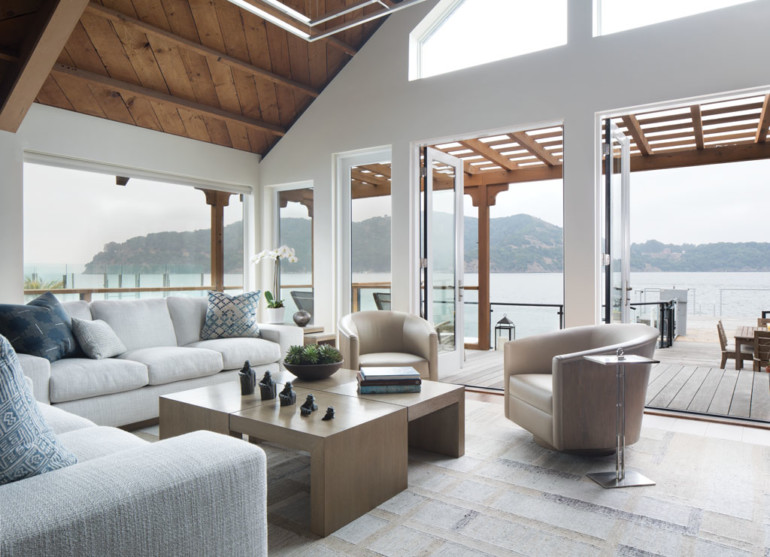CALLY KALLENBERG, a principal at the Manhattan Beach office of Joan Halperin Interior Design, has fond memories of the five years she spent living in Marin. “My son was born here; we made great friends and were setting down roots,” she says. But a professional opportunity for her then-husband meant saying goodbye to a community she’d grown to love. So 13 years later, when her firm got an assignment to oversee the remodel of a 1945 waterfront home in Tiburon, she did a happy dance. “The home had so much potential,” Kallenberg says. “And the prospect of being able to reconnect with friends and visit my old stomping grounds was icing on the cake.”
Her clients, two professionals with a primary residence in the South Bay, bought the property in 2015. “They love to sail and already had a boat docked in Tiburon, so owning a second home in the community made good sense,” Kallenberg says.
These owners join a growing population of Silicon Valley residents choosing Marin as a vacation home. The practice, while popular, is also polarizing. Many full-time residents welcome second home buyers who lovingly restore old homes, which increases property values for everyone. But for folks just trying for a foothold in the Marin real estate market, it increases competition in an already tight market. Still, one point anyone can agree on: this stunning renovation was done with extreme sensitivity to the local aesthetic. The unassuming facade blends seamlessly with neighboring homes, and the interior looks ripped from Architectural Digest.
Modernizing this particular vintage property took considerable time, patience and attention to detail. “Our directive was to create a beach-house vibe that was sophisticated but also approachable,” Kallenberg says. That meant overcoming some stumbling blocks. For starters, the team had to find ways to fix many structural deficiencies without compromising design — and get their plan through design review.
To that end, she and her partner (and mother) Joan Halperin were grateful to be collaborating with Eugene Dvorak, formerly an employee of Tiburon-based Hank Bruce Architects. (He’s since left to start his own firm.) As a local, he had a sense of which design would pass muster and which wouldn’t fly in a strictly regulated eco-conscious community. “It was a joint effort, for sure, and I think the end product illustrates the benefits of designers and architects working in tandem,” says Kallenberg, whose role in the company is to focus on furnishings. “My mom is a trained interior architect, so she and Gene were the creative force behind the floor plans.”
It took them more than two years to come up with a plan that satisfied everything on the homeowners’ wish list, addressed neighbor concerns and complied with the town’s stringent building codes.
Priority number one was opening up the space. “The house, which I suspect was last remodeled in the ’80s, was dark and choppy,” Kallenberg recalls. “It had floor-to-ceiling wood paneling, which made everything feel tight and overwhelming.” The plan called for gutting the entry level, formerly composed of a front vestibule and a catwalk leading to three tiny bedrooms served by one dated bathroom. The new design featured two generously sized bedrooms in a reconfigured space, each with an en-suite bathroom. “Our clients wanted their guests to feel as if they were staying in a hotel room, so every bedroom in the house has a private bath,” Kallenberg says.
The team also reworked the entry point to the home’s third floor, previously only accessible by an external stairwell. With the addition of a spiral staircase off the foyer, that loft-style room, which serves as a home office, now feels connected to the rest of the house. An innovative element: as you ascend the steps, they expand and attach to both the wall and the center post, eliminating that uncomfortably close feeling often associated with this design. The spiral, fabricated from steel, wood and glass, mimics the look of the home’s redesigned main stairwell; it manages to be sleek and stylish but also functional.
On the lower level, an existing wood-burning fireplace was eliminated. Two new direct-vent gas units were placed back to back — one to warm the den and another for the living room. The floor-to-ceiling fireplace surround features a combination of soapstone, hickory panels and metal elements, designed to bring the eye upward, drawing attention to the room’s soaring ceilings.
To maximize the drama of a double-height ceiling, the team added a windowpane above a set of double glass doors that open out to the home’s waterfront deck. “Originally, there was a smaller arched window on top,” Kallenberg says; it was out of synch with the home’s architectural style and, while it did reveal the water from inside the entry level, lacked any wow factor. “Now your introduction to the space is this amazing view,” says Kallenberg.
The kitchen location didn’t change, but the room now looks and works considerably better. Custom cabinets in brilliant white create the illusion of height: “The ceilings are low, but the space still feels light and airy,” Kallenberg says. It’s also tricked out with top-of-the line appliances, including a Miele steam oven and two dishwashers. “Our client loves to cook, so even though it’s a vacation house, it needed to be extremely functional.” Accordingly, the homeowners chose quartz countertops for durability but paired them with a Calacatta marble backsplash.
For furnishings, the homeowners wanted a nautical feel. “But keep in mind, they have discerning taste, so we weren’t going for a Pottery Barn sea-star motif,” Kallenberg adds. Nearly every piece in the house is custom, including a bed designed with an integrated dresser in the master bedroom, by furniture maker J. Robert Scott of Los Angeles. Commissioned as a free-floating piece of furniture, it has a leather surround headboard finished with cerused wood trim. “It looks like it was plucked out of a 1940s yacht,” Kallenberg notes. “The piece was created because we felt the room would feel too small with a bed against a wall.” Ditto for the night tables built from coordinating material, which swivel over the bed to allow additional floor space.
And while the master is small, it opens directly into the den. Dividing the two spaces is a set of bi-folding sliding doors. “This basically doubles the size of their bedroom,” Kallenberg says. “The idea was to utilize the entire space as a bedroom, except on occasions when they’re entertaining.”
Lighting the main room also required out-of-the-box thinking. “In a wood-framed ceiling there’s no way to recess cans, and if you don’t want to install track lighting you don’t have a lot of options, especially in Tiburon where it all has to be LED,” Kallenberg says. So she and her mother came up with the idea of creating two free-floating sculptural squares of light, with one suspended inside the other, which provides both up and down lighting. “It reflects off the ceiling and lights the living space.”
While the clients gave the designers a wide berth, there was one non-negotiable point: “They wanted neutral furniture for the living room,” Kallenberg says. A conventional approach would have been to upholster the sofas in white linen, echoing the upscale maritime motif. Instead, Kallenberg suggested a high-performance synthetic fabric, which approximates the look and feel of linen but can also survive a little roughhousing and won’t fade over time. “It’s a vacation house,” she points out. “We wanted the house to feel relaxing. How do you do this if you’re always worrying about guests with sand on their feet or the occasional red wine spill?”
Because nearly every window in this home looks out on the bay, the team went with solar shades, which filter light but preserve views. It’s a great option when privacy isn’t the primary objective — which was the case here: “Unless you have a telescope, or happen to be a sea lion,” Kallenberg quips, “no one is going to be able to see into the house.”
The renovation, completed last summer, is getting a workout. “I think they are in there as often as they can be,” she says. And while there’s an unquestionable satisfaction in closing the books on a project of this scope, for her the ending was bittersweet. “I miss having an excuse to spend time in Marin,” she admits. “Find me another project and I’ll be back in a heartbeat.”
[gtx_gallery]

Dawn Margolis Denberg has worked as a professional journalist for 20 years. Her work has appeared in top publications, including Wired, Shape and Parenting. She has also written several books for children including, The Men in Black Agent’s Manual The Official Godzilla Movie Fact Book. And, most recently, an episodic audio series for Tales Untold.


